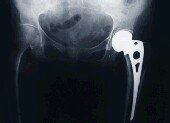Total Hip Arthroplasty Treats Developmental Hip Dysplasia
Cementless modular total hip arthroplasty together with subtrochanteric osteotomy appears to be a satisfactory treatment for patients with prior Crowe Group-IV dysplasia of the hip, according to research published in the March 16 issue of The Journal of Bone & Joint Surgery.

FRIDAY, April 1 (HealthDay News) -- Cementless modular total hip arthroplasty together with subtrochanteric osteotomy appears to be a satisfactory treatment for patients with prior Crowe Group-IV dysplasia of the hip, according to research published in the March 16 issue of The Journal of Bone & Joint Surgery.
Masaki Takao, M.D., Ph.D., of the Osaka University Graduate School of Medicine in Japan, and colleagues studied outcomes in 25 patients (33 hips) who had Crowe Group-IV dysplasia of the hip as children. At a mean age of 60, they were treated with a modular cementless prosthesis. The mean follow-up was eight years, and subtrochanteric femoral shortening osteotomy was performed with a step-cut design.
The researchers found that patients experienced an improvement in hip score from 9 to 16 points (out of 18 possible), and the mean limb-length discrepancy was reduced from 5.1 cm to 2.8 cm in 17 patients whose discrepancy involved unilateral involvement. At the last follow-up, two patients had a positive Trendelenburg sign, and a slight limp was notable in three. Postoperative dislocations were seen in two hips. Within two years after the surgery, one hip had progressive radiolucent lines around the proximal femoral sleeve, which was followed by progressive stem subsidence. One femoral stem was revised.
"Cementless, modular total hip arthroplasty combined with subtrochanteric osteotomy for the treatment of patients with prior Crowe Group-IV developmental dysplasia of the hip resulted in satisfactory outcomes. Hips with poor bone quality and a developmentally short femoral neck present technical challenges with regard to achieving sufficient rotatory stability, following osteotomy, for osseointegration of the modular implants," the authors write.
AbstractFull Text (subscription or payment may be required)
